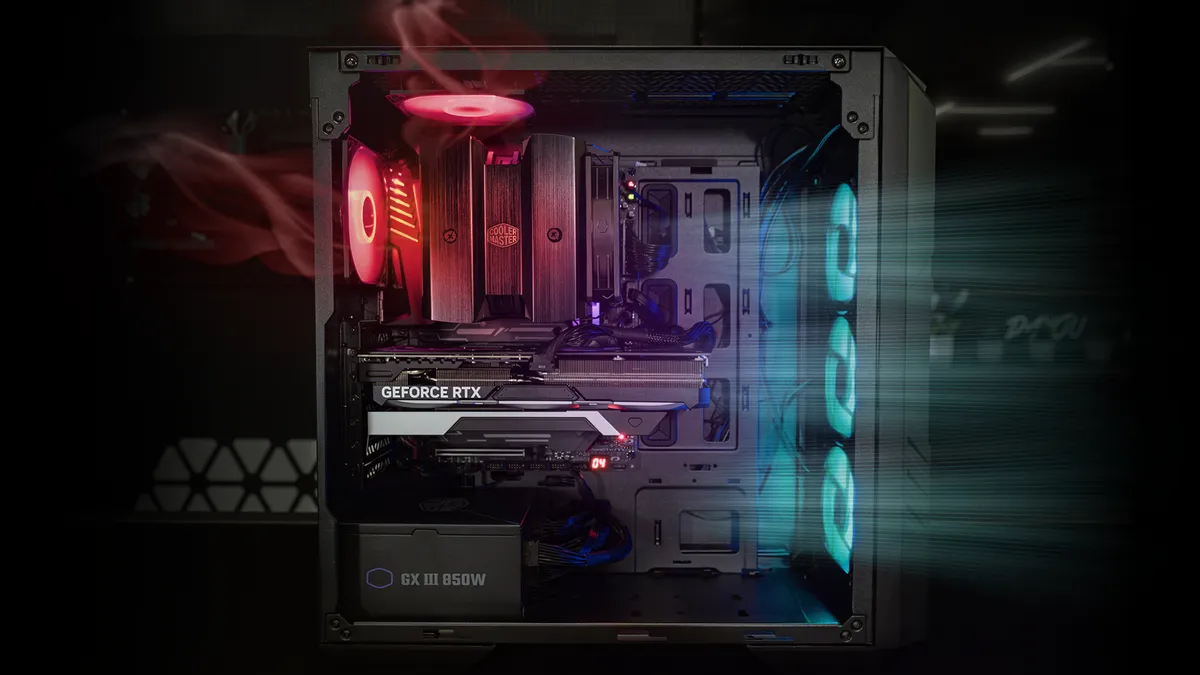When gaming gets intense, so does your PC. High-performance components generate a lot of heat, and without proper cooling, you risk thermal throttling, loud fan noise, or even long-term damage. Fortunately, there are practical ways to keep your PC cool and whisper-quiet—even during demanding gaming marathons.
In this guide, you’ll learn how to optimize airflow, choose the right cooling setup, manage fan speeds, and keep noise levels under control.
Why Cooling Matters
Consequences of Poor Cooling:
- Thermal throttling: CPU/GPU reduce speed to avoid overheating
- Louder fan noise: Fans spin faster trying to compensate
- Shortened component lifespan
- Unexpected shutdowns or blue screens
Proper cooling not only ensures performance but also preserves the health of your components.
1. Use a Well-Ventilated Case
Your PC case plays a huge role in cooling efficiency.
What to look for:
- Mesh front panel for improved airflow
- Support for multiple fans or radiators
- Good cable management space (less clutter = better airflow)
- Dust filters on intake and exhaust ports
Popular airflow-optimized cases:
- Lian Li Lancool II Mesh
- Fractal Design Meshify 2
- Cooler Master HAF series
2. Optimize Airflow with Fan Placement
Airflow should be smooth and directional.
Fan setup tips:
- Intake fans (front/bottom) pull cool air in
- Exhaust fans (rear/top) push hot air out
- Aim for positive pressure: more intake than exhaust (helps reduce dust buildup)
Use at least 2 front intakes and 1 rear exhaust for effective airflow.
3. Clean Dust Regularly
Dust buildup blocks airflow and insulates heat.
Cleaning checklist:
- Use compressed air or a soft brush
- Focus on CPU coolers, GPU fans, PSU filters, and intake grills
- Clean every 1–2 months, more often if your space is dusty or if you have pets
4. Manage Fan Speeds with Software
Loud fans usually run at high speed when temps spike. You can fine-tune this behavior.
Recommended tools:
- BIOS/UEFI: Most motherboards let you set custom fan curves
- MSI Afterburner: Adjust GPU fan behavior
- FanControl (free software): Create quiet yet efficient fan profiles
Create a custom fan curve that:
- Keeps fans slow and quiet during idle/light use
- Ramps up gradually during heavy loads
- Avoids sudden RPM jumps (which create noise)
Upgrade Your CPU Cooler
Stock coolers often struggle with gaming workloads.
Best cooling upgrades:
- Air Coolers:
- Be Quiet! Dark Rock 4
- Noctua NH-D15
- AIO Liquid Coolers:
- Corsair H100i / H150i
- NZXT Kraken X63
- Ensure your case supports the cooler’s height or radiator size
6. Improve GPU Cooling and Spacing
Modern GPUs can run hot—especially in tight cases.
Best practices:
- Leave at least 1–2 PCIe slots of space below the GPU
- Keep side panels off temporarily if temps are high
- Consider aftermarket GPU coolers or hybrid cooling models
- Use vertical GPU mounts if your case supports it (for better airflow)
7. Use Quality Thermal Paste
Thermal paste transfers heat from your CPU/GPU to the cooler. Over time, it can dry out.
Paste tips:
- Replace thermal paste every 2–3 years (or after changing coolers)
- Apply a pea-sized dot in the center of the CPU
- Recommended brands: Arctic MX-6, Noctua NT-H2, Thermal Grizzly Kryonaut
8. Undervolt Your CPU or GPU
Undervolting reduces heat and power draw—without losing performance.
Tools:
- Intel XTU or AMD Ryzen Master (for CPU)
- MSI Afterburner (for GPU undervolting curve)
Undervolting:
- Lowers temps by up to 10–15°C
- Reduces fan noise
- Preserves battery life on gaming laptops
9. Monitor Temperatures in Real Time
Keep an eye on system temps—especially during gaming.
Best tools:
- HWiNFO
- CoreTemp
- MSI Afterburner (with RivaTuner overlay)
Target temps:
- CPU: under 85°C
- GPU: under 85°C
- SSD: under 70°C
If temps exceed these, revisit airflow or undervolting.
10. Control Ambient Temperature
Sometimes, the environment is the problem.
Tips for room cooling:
- Use a desktop fan to help airflow
- Avoid placing PC near heat sources or direct sunlight
- Use AC or ventilation in closed rooms
Room temp above 30°C significantly raises internal PC temps.
Wrapping Up: Quiet Power, Cool Performance
Keeping your PC cool and quiet isn’t just about comfort—it’s about performance, longevity, and peace of mind. With a few tweaks to airflow, fan curves, and thermal management, you can enjoy whisper-silent gaming even under full load.
Next up: “Best Budget PC Builds for Gaming in 2025”
Highlights from “How to Keep Your PC Cool and Quiet During Gaming Sessions”
Choose a ventilation-optimized case
A mesh-front chassis (like the Lian Li Lancool II Mesh) naturally improves airflow musetex.com+6tomshardware.com+6amazon.com+6.
Balanced fan placement
Create smooth airflow: front/bottom intake + top/rear exhaust. Cooler Master recommends setups with 2–3 intake fans and 1–2 exhaust fans coolermaster.com+1gamemaxpc.com+1.
Clean and maintain
Dust inside your PC blocks airflow. Clear dust every 1–2 months using compressed air, and clean PSU filters and grilles to maintain efficiency coolermaster.com+1gamemaxpc.com+1.
Fine-tune fan speeds
Use BIOS/UEFI, MSI Afterburner, or FanControl to create fan curves that ramp up gradually—keeping temperatures under control while reducing noise coolermaster.com+2tomshardware.com+2intel.com+2.
Upgrade to more effective cooling
Invest in quality coolers—like Noctua NH-D15 for air or high-quality AIOs for liquid cooling. Undervolting CPU/GPU can also drop temps by 10–15 °C and reduce noise .
Monitor temps & environment
Keep temps below 85 °C during load for CPU/GPU and below 70 °C for SSDs. Use tools like HWiNFO for real-time monitoring. Additionally, consider room ventilation and external fans to reduce ambient temperature .
Following these steps ensures your gaming PC stays cool, fast, and nearly silent—even under heavy load.
Next up: “Best Budget PC Builds for Gaming in 2025” — ready to go as soon as you say the word!
